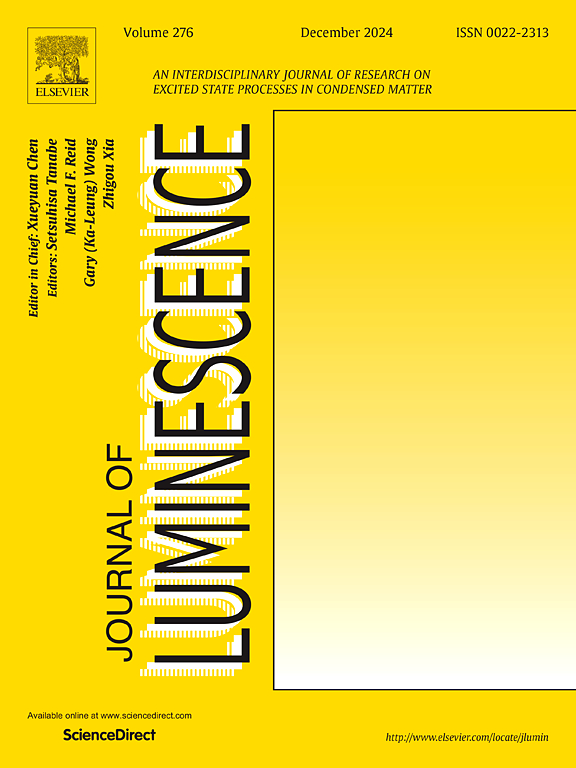铕与β-二酮和二苯基膦酸盐配合物的x射线激发光学发光性质研究
IF 3.3
3区 物理与天体物理
Q2 OPTICS
引用次数: 0
摘要
二苯基膦配体可以有效地取代三价稀土阳离子配位化合物中的水分子。本文研究了以β-二酮和二苯基膦酸盐为配体的含三价稀土阳离子配位化合物的合成和表征。合成的化合物产生了具有独特发光特性的晶体材料。铕配合物表现出强烈的红色发射,强调了它们在显示和照明方面的潜在应用。FT-IR光谱证实了配体与稀土阳离子的配位,而UV-Vis漫反射分析则提供了对它们的电子跃迁的见解。对激发态寿命和理论Anrad值的分析表明,合成材料中存在或不存在像水分子和Csp3-H键这样的失活基团。对这些化合物的闪烁特性进行了评价,表明它们适用于闪烁体和x射线诱导光动力治疗。[Eu-dpp]碎片有效地吸收x射线并发射可见辐射,产生单线态氧(1O2)用于治疗应用。本文章由计算机程序翻译,如有差异,请以英文原文为准。
Europium complex with β-diketone and diphenylphosphinate ligands: Investigating its X-ray excited optical luminescent properties
Diphenylphosphinate ligand can effectively replace water molecules in coordination compounds with trivalent rare earth cations. This study investigates the synthesis and characterization of coordination compounds containing trivalent rare earth cations using β-diketones and diphenylphosphinate as ligands. The synthesized compounds yielded crystalline materials with distinct luminescent properties. Europium complexes exhibited intense red emission, underscoring their potential applications in displays and lighting. FT-IR spectroscopy confirmed the coordination of ligands to rare earth cations, while UV–Vis diffuse reflectance analysis provided insights into their electronic transitions. Analysis of excited state lifetimes and theoretical Anrad values suggested minimal presence or absence of deactivating groups like water molecules and Csp3-H bonds in the synthesized materials. The scintillation properties of these compounds were evaluated, indicating their suitability for scintillators and X-ray-induced photodynamic therapy. The [Eu-dpp] fragment efficiently absorbs X-rays and emits visible radiation, generating singlet oxygen (1O2) for therapeutic applications.
求助全文
通过发布文献求助,成功后即可免费获取论文全文。
去求助
来源期刊

Journal of Luminescence
物理-光学
CiteScore
6.70
自引率
13.90%
发文量
850
审稿时长
3.8 months
期刊介绍:
The purpose of the Journal of Luminescence is to provide a means of communication between scientists in different disciplines who share a common interest in the electronic excited states of molecular, ionic and covalent systems, whether crystalline, amorphous, or liquid.
We invite original papers and reviews on such subjects as: exciton and polariton dynamics, dynamics of localized excited states, energy and charge transport in ordered and disordered systems, radiative and non-radiative recombination, relaxation processes, vibronic interactions in electronic excited states, photochemistry in condensed systems, excited state resonance, double resonance, spin dynamics, selective excitation spectroscopy, hole burning, coherent processes in excited states, (e.g. coherent optical transients, photon echoes, transient gratings), multiphoton processes, optical bistability, photochromism, and new techniques for the study of excited states. This list is not intended to be exhaustive. Papers in the traditional areas of optical spectroscopy (absorption, MCD, luminescence, Raman scattering) are welcome. Papers on applications (phosphors, scintillators, electro- and cathodo-luminescence, radiography, bioimaging, solar energy, energy conversion, etc.) are also welcome if they present results of scientific, rather than only technological interest. However, papers containing purely theoretical results, not related to phenomena in the excited states, as well as papers using luminescence spectroscopy to perform routine analytical chemistry or biochemistry procedures, are outside the scope of the journal. Some exceptions will be possible at the discretion of the editors.
 求助内容:
求助内容: 应助结果提醒方式:
应助结果提醒方式:


